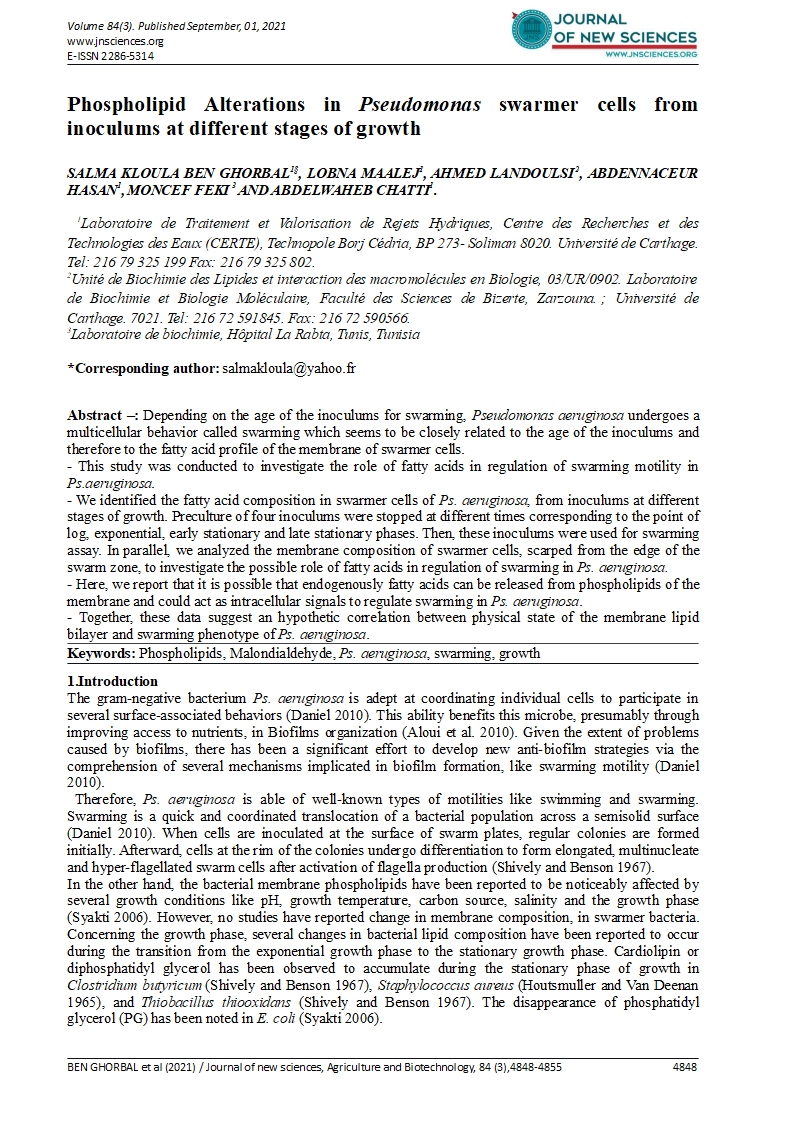

- Category: Volume 84
- Hits: 2325
Phospholipid Alterations in Pseudomonas swarmer cells from inoculums at different stages of growth
SALMA KLOULA BEN GHORBAL1
LOBNA MAALEJ1
AHMED LANDOULSI2
ABDENNACEUR HASAN1
MONCEF FEKI 3
ABDELWAHEB CHATTI1
1Laboratoire de Traitement et Valorisation de Rejets Hydriques, Centre des Recherches et des Technologies des Eaux (CERTE), Technopole Borj Cédria, BP 273- Soliman 8020. Université de Carthage. Tel: 216 79 325 199 Fax: 216 79 325 802.
2Unité de Biochimie des Lipides et interaction des macromolécules en Biologie, 03/UR/0902. Laboratoire de Biochimie et Biologie Moléculaire, Faculté des Sciences de Bizerte, Zarzouna. ; Université de Carthage. 7021. Tel: 216 72 591845. Fax: 216 72 590566.
3Laboratoire de biochimie, Hôpital La Rabta, Tunis, Tunisia
Abstract –: Depending on the age of the inoculums for swarming, Pseudomonas aeruginosa undergoes a multicellular behavior called swarming which seems to be closely related to the age of the inoculums and therefore to the fatty acid profile of the membrane of swarmer cells.
- This study was conducted to investigate the role of fatty acids in regulation of swarming motility in Ps.aeruginosa.
- We identified the fatty acid composition in swarmer cells of Ps. aeruginosa, from inoculums at different stages of growth. Preculture of four inoculums were stopped at different times corresponding to the point of log, exponential, early stationary and late stationary phases. Then, these inoculums were used for swarming assay. In parallel, we analyzed the membrane composition of swarmer cells, scarped from the edge of the swarm zone, to investigate the possible role of fatty acids in regulation of swarming in Ps. aeruginosa.
- Here, we report that it is possible that endogenously fatty acids can be released from phospholipids of the membrane and could act as intracellular signals to regulate swarming in Ps. aeruginosa.
- Together, these data suggest an hypothetic correlation between physical state of the membrane lipid bilayer and swarming phenotype of Ps. aeruginosa.
Keywords: Phospholipids, Malondialdehyde, Ps. aeruginosa, swarming, growth

